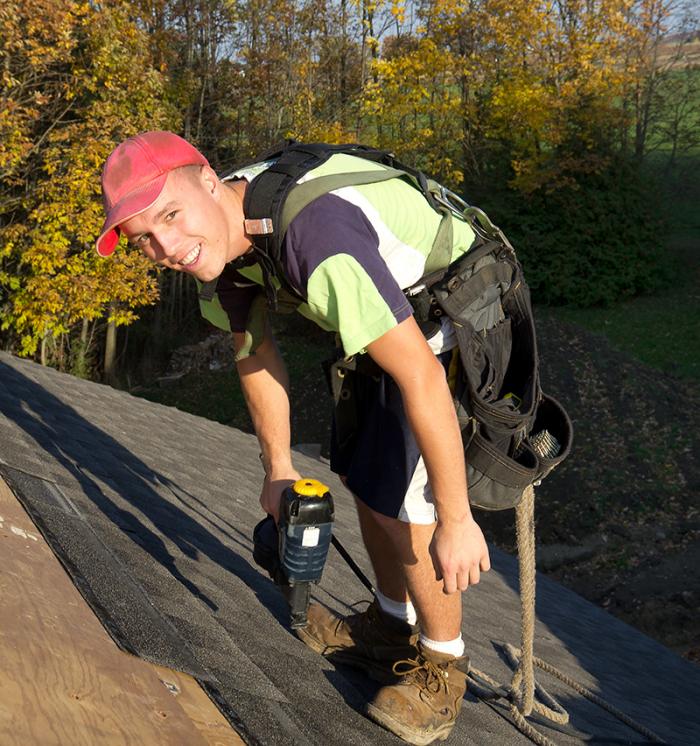
About
Ask yourself...
- Do you like working outside?
- Are you physically fit and keen on exercise?
- Could you work in high places?
- Do you like working with your hands?
- Are you comfortable in hot temperatures?
If the answer to these questions is yes, then a career as a Roofer/Shingler could be right for you.
Roofers install, repair or replace flat roofs and shingles, shakes or other roofing tiles on sloped roofs.
Shinglers install and replace shingles, tiles and similar coverings on sloped roofs.
Roofers/shinglers may also waterproof basements, foundations and decks.
As a Roofer/Shingler, you will be employed by roofing and general contractors for construction or repair jobs, or you may be self-employed.
Duties
As a Roofer/Shingler, your duties may include the following:
- Installing, repairing or replacing roofing systems using materials such as asphalt and gravel
- Installing, repairing or replacing shingles and other roofing tiles
- Applying waterproof coatings to concrete surfaces
- Installing and repairing metal roofs using hand and power tools
- Installing scaffolding to provide safe access to roofs
- Estimating required materials and costs
Work Conditions
The standard work week for roofers and shinglers is 40 hours (8 hours a day, 5 days a week). As with many careers in construction, there are peak periods that will require you to work overtime. The number of additional hours you work each week depends on the construction sector and region you work in, and will vary from one job to the next.
Most roofers and shinglers work steadily throughout the year because roof systems need to be replaced every 15 to 20 years.
As a Roofer/Shingler, you will work mostly outdoors, and with a crew of other construction professionals. The job can be physically demanding – you may have to lift heavy materials, and roofing can be quite hot during the summer.
As with all careers in the construction industry, safety is the top priority. Roofers and shinglers are trained to work safely and wear special equipment such as safety harnesses to protect against injury.
Training and Certification
Apprenticeship
Apprenticeship involves both classroom studies and on-the-job training under the supervision of a certified Roofer/Shingler, called a journeyperson.
As an apprentice, you earn while you learn and are paid by the hour while working on the job site. Wages start at about 65% of a journeyperson’s hourly rate and increase during your apprenticeship until you reach the full rate.
Entering an apprenticeship program
Requirements for roofer/shingler apprenticeship programs vary across Canada. In most provinces and territories, you must have a Grade 9 education or equivalent to enter the program.
Some provinces and territories offer secondary school apprenticeship programs that allow high school students to work towards a career as a Roofer/Shingler.
For more information, check out the apprenticeship section.
Program length
Apprenticeship training programs for roofers and shinglers vary across Canada, but generally involve four 12-month periods, including at least 5,860 hours of on-the-job training, three six-week blocks of technical training and a final certificate exam.
Related work experience or completion of a roofer/shingler program at a college or technical institute can reduce the time required to complete your apprenticeship.
Certification
Certification is required in Quebec. It is available but voluntary in Alberta, British Columbia, Manitoba, New Brunswick, Newfoundland and Labrador, the Northwest Territories, Nova Scotia, Ontario, Prince Edward Island, Saskatchewan and the Yukon. Where certification is not available, it may be possible to study as an apprentice through your local labour organization. Even where certification is voluntary, it is still recommended as it tells employers and other workers that you are a skilled professional, and it also helps you get jobs.
To be certified as a Roofer/Shingler, you usually need to complete of a four-year apprenticeship program. Once you successfully complete the required on-the-job training, technical training and exams, you are awarded a journeyperson certificate.
If you have more than three years of on-the-job experience and some high school, college or industry courses in roofing/shingling, you may be eligible for certification in some provinces and territories.
As a certified Roofer/Shingler, you may attempt the Interprovincial Exam to qualify for the Interprovincial Standards’ Red Seal. With a Red Seal, you can work as a Roofer/Shingler anywhere in Canada.
To keep their skills current, those in this profession must keep up with new technologies by reading and speaking with others in their field.
Courses
Anticipated In-Demand Regions
- Nova Scotia
- Ontario - Eastern Region
- Ontario - Greater Toronto Area (GTA)
- Ontario - Northern Region
Wage
 | ||
| Mid range $54,080 |  | High range $81,220 |
The “mid range” wage is based on the national “median” wage reported in the Job Bank career profile for this National Occupational Category (NOC): 7291
Note: Some career profiles may have more than one NOC code associated with them.
More good stuff
- The Castagra Roofing Scholarship Program aims to support individuals passionate about bringing more sustainability and innovation to the industry.
- The National Women in Roofing council aims to support and advance the careers of women roofing professionals in Canada.







